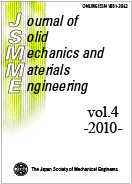Volume 4, Issue 6
Special Issue of APCMM2009 I
Displaying 1-26 of 26 articles from this issue
- |<
- <
- 1
- >
- >|
Papers
-
2010 Volume 4 Issue 6 Pages 610-620
Published: 2010
Released on J-STAGE: June 30, 2010
Download PDF (481K) -
2010 Volume 4 Issue 6 Pages 621-637
Published: 2010
Released on J-STAGE: June 30, 2010
Download PDF (1452K)
Special Issue of APCMM2009 I
-
2010 Volume 4 Issue 6 Pages 638
Published: 2010
Released on J-STAGE: June 30, 2010
Download PDF (115K)
Review
-
2010 Volume 4 Issue 6 Pages 639-651
Published: 2010
Released on J-STAGE: June 30, 2010
Download PDF (3531K)
Papers(Special Issue)
Plenary Lectures
-
2010 Volume 4 Issue 6 Pages 652-657
Published: 2010
Released on J-STAGE: June 30, 2010
Download PDF (344K) -
2010 Volume 4 Issue 6 Pages 658-668
Published: 2010
Released on J-STAGE: June 30, 2010
Download PDF (744K)
Structural Design, Optimal Design
-
2010 Volume 4 Issue 6 Pages 669-677
Published: 2010
Released on J-STAGE: June 30, 2010
Download PDF (482K) -
2010 Volume 4 Issue 6 Pages 678-684
Published: 2010
Released on J-STAGE: June 30, 2010
Download PDF (662K) -
2010 Volume 4 Issue 6 Pages 685-691
Published: 2010
Released on J-STAGE: June 30, 2010
Download PDF (706K) -
2010 Volume 4 Issue 6 Pages 692-699
Published: 2010
Released on J-STAGE: June 30, 2010
Download PDF (426K) -
2010 Volume 4 Issue 6 Pages 700-710
Published: 2010
Released on J-STAGE: June 30, 2010
Download PDF (1438K) -
2010 Volume 4 Issue 6 Pages 711-719
Published: 2010
Released on J-STAGE: June 30, 2010
Download PDF (1306K)
Fracture Mechanics, Crack Growth
-
2010 Volume 4 Issue 6 Pages 720-726
Published: 2010
Released on J-STAGE: June 30, 2010
Download PDF (1189K) -
2010 Volume 4 Issue 6 Pages 727-737
Published: 2010
Released on J-STAGE: June 30, 2010
Download PDF (343K)
Measurement Technique, Characteristic Evaluation
-
2010 Volume 4 Issue 6 Pages 738-748
Published: 2010
Released on J-STAGE: June 30, 2010
Download PDF (434K) -
2010 Volume 4 Issue 6 Pages 749-760
Published: 2010
Released on J-STAGE: June 30, 2010
Download PDF (2070K) -
2010 Volume 4 Issue 6 Pages 761-770
Published: 2010
Released on J-STAGE: June 30, 2010
Download PDF (1685K) -
2010 Volume 4 Issue 6 Pages 771-780
Published: 2010
Released on J-STAGE: June 30, 2010
Download PDF (2806K) -
2010 Volume 4 Issue 6 Pages 781-795
Published: 2010
Released on J-STAGE: June 30, 2010
Download PDF (1185K)
Fatigue Strength, Fatigue Crack
-
2010 Volume 4 Issue 6 Pages 796-805
Published: 2010
Released on J-STAGE: June 30, 2010
Download PDF (1534K) -
2010 Volume 4 Issue 6 Pages 806-815
Published: 2010
Released on J-STAGE: June 30, 2010
Download PDF (7965K) -
2010 Volume 4 Issue 6 Pages 816-829
Published: 2010
Released on J-STAGE: June 30, 2010
Download PDF (1656K) -
2010 Volume 4 Issue 6 Pages 830-839
Published: 2010
Released on J-STAGE: June 30, 2010
Download PDF (1786K) -
2010 Volume 4 Issue 6 Pages 840-848
Published: 2010
Released on J-STAGE: June 30, 2010
Download PDF (1124K) -
2010 Volume 4 Issue 6 Pages 849-855
Published: 2010
Released on J-STAGE: June 30, 2010
Download PDF (667K)
Strength at Elevated Temperature, Life Prediction
-
2010 Volume 4 Issue 6 Pages 856-863
Published: 2010
Released on J-STAGE: June 30, 2010
Download PDF (553K)
- |<
- <
- 1
- >
- >|
